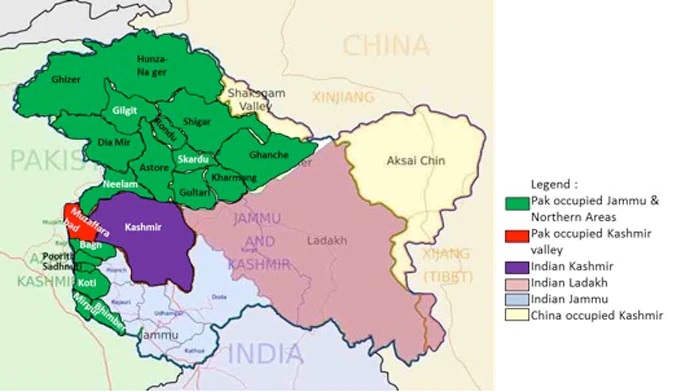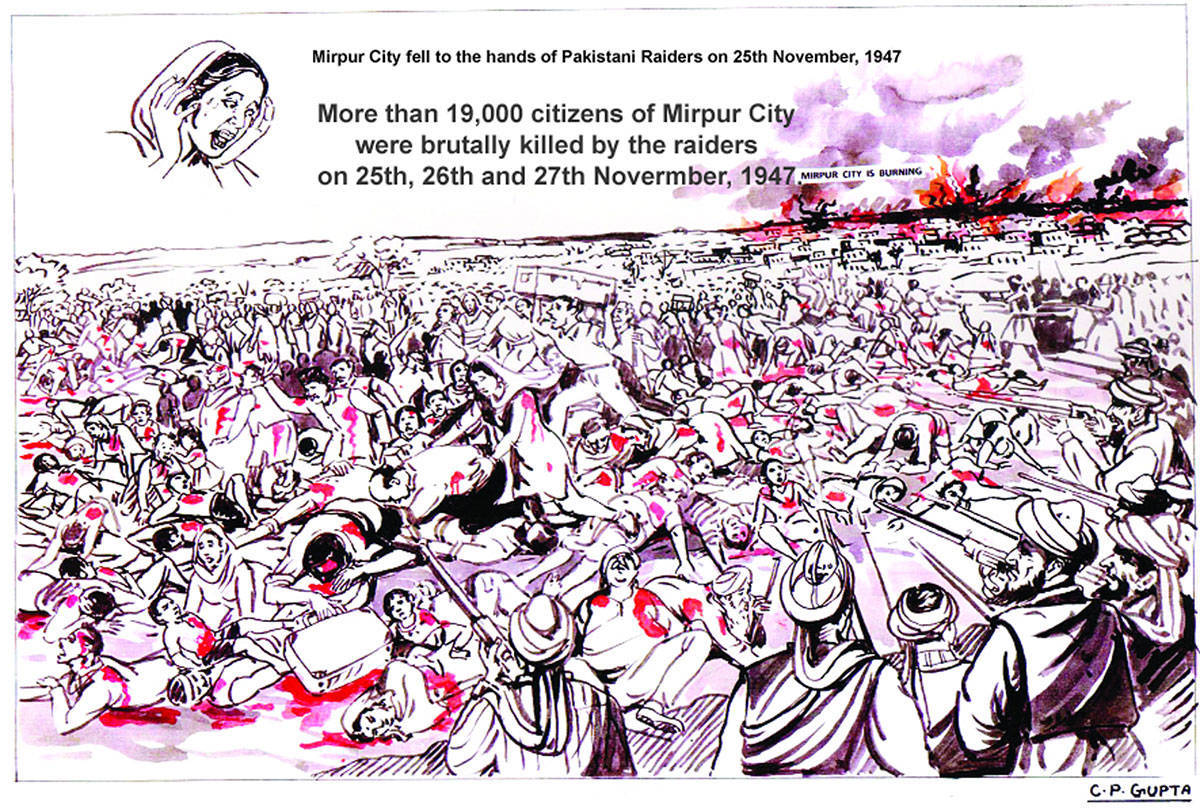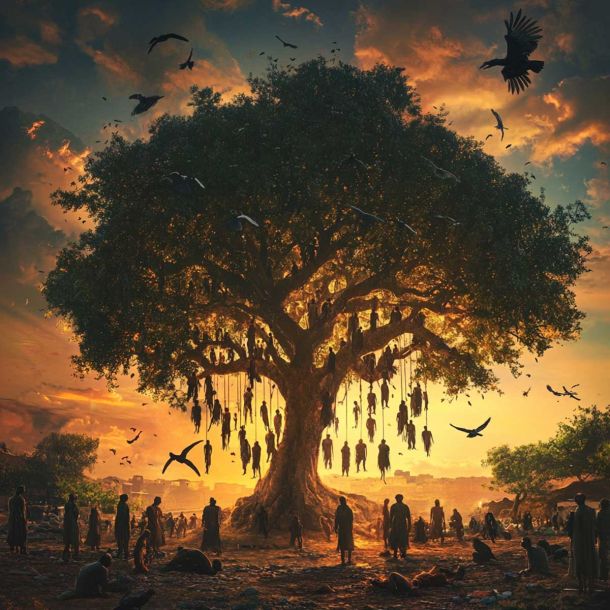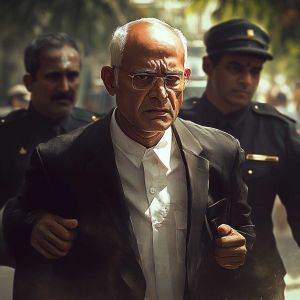Sanatan Articles
Satyaagrah
Written on
Satyaagrah
Written on
Satyaagrah
Written on
Satyaagrah
Written on
Satyaagrah
Written on
JOIN SATYAAGRAH SOCIAL MEDIA
Why Hindu-Sikh genocide of Mirpur in 1947 ignored? Why inhuman crimes of Radical Islamists always hidden in India?

A lot has been written about the expulsion of Hindus from Bangladesh, from the Kashmir valley, Hindus and Sikhs from Pakistan, and so forth, but very little has been written about the expulsion and killing – termed missing here – of the Hindus, and Sikhs from regions of Pakistan-occupied Jammu and Kashmir.
Indeed, the very name given – Pakistan occupied Kashmir (PoK) is a misnomer. A look at the map shows that Pakistan occupied region of Jammu and Kashmir consists roughly the then districts of Bhimber (Mirpur, Kotli and Bhimber tehsils), Muzaffarabad (Muzaffarabad tehsil), parts of Poonch (Bagh and Sadhnuti tehsils), Gilgit and the Frontier Ilaqas, and Skardu and Baltistan part of Ladakh.
Of these regions, only Muzaffarabad (coloured red in the map), which constitutes a small fraction of the area, belongs to Kashmir region of the Jammu and Kashmir. Consequently, Pakistan-occupied Jammu and Kashmir (PoJK) is the accurate term.
PoJK had a substantial number of Hindus and Sikhs, who went missing from PoJK when Pakistan invaded Kashmir in 1947. In this article, we attempt to quantify the number of Hindus, and Sikhs that went missing from PoJK. It may be added that there were no Buddhists recorded in these regions.
 Map of Jammu and Kashmir showing Pakistan-occupied territories. |
Perpetrator: Pakistan Army, Muslim insurgents and Afghan tribesmen
Date: 25-27 November, 1947
Number: At least 35,000 Hindus and Sikhs brutally murdered, around 3000 severely injured and another 5000 taken as prisoners. At least 5000 women and girls raped.
The last ruler of undivided Jammu and Kashmir (including POJK) was Hindu king, Maharaja Hari Singh. Population of Hindu and Sikhs were in good percentage. After genocide of Kashmiri Hindus in 1990, Kashmir had almost become empty of Hindus. Kashmiri Hindus had been given three options by the Islamic extremists and terrorists: Ralive, Tsaliv ya Galive (either convert to Islam, leave the land, or die). Ethnic cleansing of Kashmiri Hindus was perpetrated to clear the way for total Islamization of this pious land of Rishi Kashyap.
 Photo credit Twitter |
Where did Hindus and Sikhs in Pakistan Occupied Kashmir disappear
After the Timur massacre of Delhi in 1358, the massacre of Mirpur a bustling trade centre and historic walled city of Jammu and Kashmir now in Pak Occupied Kashmir on 25th of Nov' 1947 was the worst massacre of Indian history. Recently declassified British Government documents reveal that the United Kingdom had decided that the Princely State of Jammu and Kashmir or part of it must go to Pakistan for strategic reasons of importance, of Jhelum bridge, irrigation/hydroelectric potentials of Mangla dam in Mirpur for the economic needs of Pakistan and the need of an air base in western J&K close to Russia and China. The creation of Pakistan was itself for the strategic reasons to counter the growing military influence of Soviet Union after World War II. Due to its proximity with China and Russia, presence of warm water sea port of Karachi and the interests of western oil companies in central Asia made Pakistan important.
1947 is remembered as the year of our Independence and the year that witnessed India-Pakistan partition. The dreadful year is also remembered for the most horrible massacre of Indian history.
Background of the Massacre
In the spring of 1947, persecution of Hindus and Sikhs in Punjab had already started, in anticipation of the partition of India. The severity of hate crimes against Hindus increased from August 1947, leading to scores of Hindus and Sikhs migrating from Punjab into Mirpur. In view of the increasing tension in Kashmir, Maharaha Hari Singh imposed marshal law.
The Poonch Muslims wanted Kashmir to accept the offer of accession to Pakistan. Under the leadership of Abdul Qayyum, rebel groups organized themselves in Kashmir, comprising Muslims who wanted Kashmir to be a part of Pakistan. It comprised many ex-military soldiers of Poonch who had fought for the British in World War 2. Most of these rebels left their families in western Punjab, in Pakistan, and came back with renewed arms and ammunition. There was a clear agenda to wreak havoc in Kashmir.
 |
The Dogra troops of Kashmir countered the insurgents in the months of September, for which they were criticized as persecuting Muslims in the state. This argument is quite vacant, since the actions of the troops were against rebels who wanted to forcibly bend the government into merging with Pakistan, and were taking over cities under their rule.
During the months of September and October, there was influx of Hindu and Sikh refugees from Pakistan, and also armed Muslim insurgents and Afghan tribals. The tribals from the Afghan frontier belonged to the no-man’s land near the Durand’s line, who were not governed even by the British, as the latter failed to control them—the Wahsuds, Afridis, Wazirs etc. They were expert in military craft, and knew how to operate modern military machinery as well. They poured into the Kashmir valley in fleets of lorries, numbering more than 5000 men and 300 lorries initially. Their raids were far more brutal. They finished everyone in their path. The city of Barahmullah faced this brutal onslaught. Out of 14,000 population, only 1000 remained after the massacre in Barahmullah.
Before India and Pakistan got freedom from Britishers on 15 August 1947, rebellion had occurred in Poonch and Mirpur districts of undivided Jammu and Kashmir against Maharaja Hari Singh. Taking advantage of rebellion, Pakistani Army conceived a military plan under the code name of “Operation Gulmarg” to attack Jammu and Kashmir with an intention to capture it. It is said that the planning and preparation for Operation Gulmarg reportedly commenced as early as Aug 1947 prior to India and Pakistan got independence from British rule.
Operation Gulmarg was placed under the close guidance of British military officers. Pashtun tribes Lashkers from Dir and Waziristan areas were roped in under the direct command of Col. Akbar Lone of Pak army code named Gen. Tariq and soon armed attacks and looting started in early Sept.
in Poonch and Kotli area, about 400 looters entered Owen on 2nd and 3rd Sept, followed by Pak regular army and ex army men. The town of Bhimber fell at the same time when Indian troops were air lifted of Srinagar on 27th of Oct. 1947. The population of the town swelled from 3000 to 5000 with Hindu migrants from the adjoining areas. All assembled in a small tehsil building – women and children were taken hostage while the males were put to sword. Soon, other areas fell one after another and the focus of attention and sending the Indian reinforcement was valley centric as Pt. Nehru completely gave the command of troops movement to Sheikh Mohd Abdulla side lining Sardar Patel.
Maharaja Hari Singh - The Last Hindu King of Kashmir
When Maharaja Hari Singh, the ruler of Jammu and Kashmir, was weighing option between merging with India and staying as independent sovereign state, Pakistan under Operation Gulmarg attacked Jammu and Kashmir on 22 October 1947 with tribal militias and its Army to capture It. Panicked Maharaja Hari Singh appealed India for help. To protect Jammu and Kashmir, it was imperative for Maharaja Hari Singh to sign on “Instrument of Accession to India.”
Upon turbulence in Kashmir in October 1947, Maharaja Hari Singh made an urgent appeal to government of India to send troops to defend the land and the people of Kashmir. He soon left for Jammu by road. Nehru and Lord Mountbatten made it clear that they would not send aid until the Maharaja signed the instrument of accession.
 |
The instrument of accession was signed on October 26, 1947, making Kashmir a part of India. What followed was a carnage against the Hindus and Sikhs in Mirpur, which is located on the border of Pakistan and Kashmir, now a part of “Azad” Kashmir, a part of Pakistan Occupied Kashmir (POK).
 Maharaja Hari Singh Of Jammu and Kashmir & Maharani Tara Devi during an interaction with people in Jammu & Kashmir - By Rohit |
Following the merger of Jammu and Kashmir with India, Indian troops were sent to Srinagar on 26 October 1947. This was the first India Pakistan war of 1947-48, which continued till one year and two months.
When Maharaja Hari Singh had signed on the Instrument of Accession to merge with India on 26 October 1947, it had been celebrated like “Diwali” in Mirpur with lighting of candles and bursting of crackers. 25,000 local Hindus and Sikhs felt they were safe being integral part of India. 10,000 Hindu refugees came from Punjab in Pakistan to Mirpur seeking safe shelter.
 Mirpur Massacre Map |
Mirpur under attack
Following the accession of Kashmir to India, there was a rapid influx of militant rebels, Afghan tribals and the Pakistan army into Mirpur, which had a huge number of Hindu and Sikh refugees as well. Houses were set on fire, and the onslaught was so brutal that the Indian and Kashmir army could not respond proportionate to the attack quickly enough.
The population of Mirpur swelled from 10000 to 25000 with Hindus and Sikhs migrating form nearby areas and Jhelum. A garrison of Maharaja Forces were stationed in the town. People made the fortified defences on the roof tops and on the ground by digging trenches and groups of youths were assigned the job of vigilance round the clock with primitive weapons.
On 25 November 1947, more than 35,000 Hindus and Sikhs were mercilessly slaughtered in the most barbaric way with 3,500 badly wounded by armed Pakistani tribals and Pakistani soldiers to clear the way for total Islamisation. Butchers of Pakistani Islamic radicals couldn’t even give them option either convert to Islam, leave the land, or die. The date of 25th November, a wretched day in history, is thus remembered as the Mirpur Day.
 Massacre of Sikhs and Hindus in Mirpur - 1947 |
Many advances of the enemy were repulsed till the town fell on 25th Nov 1947. Pakistan army started using modern weapons and artillery to break the walls of town. There were no supply as the town was already cut off by the fall of Bhimber in October itself; the only hope was the air dropping of supplies of food and ammunition by air till the reinforcements of Indian army reach to push away the enemy. Frantic massages were sent to Jammu over the wireless by Maharaja Forces to Jammu but in vain.
Many of the forceful attacks of the enemy were repulsed. A major attack was carried out by the enemy on 23rd of Nov 1947 from the main eastern gate and was repulsed by the death squads of Mirpuri youths in hand to hand fight. In a bad luck the only wireless equipment with the state forces broke down and the fresh stronger attack by the enemy forces on 24th morning frightened the state forces who left the battle scene with the information to the civil population to move to safer places.
|
The ensuing fierce fighting through out the next night put the enemy at bay till morning when they broke the western gate of the city next morning by using heavy artillery. The blood thirsty Pak army and tribal marauder entered the city around 8 a.m. in the morning. Under chaos and confusion people ran around terrified and the city was set on fire by the invaders.
Soon poison was distributed to the women to end their lives and not to fall into the hands of enemy. Many who didn’t get the poison were done to deaths with swords by their fathers and brothers. Men too committed suicide. The women and girls of Mirpur continued the age old tradition of Johar to escape the Islamists.
The dance of death continued till afternoon and at the end of day 18000 people were slaughtered in most barbaric way of the human history by Pak army and tribles.
10,000 of the captives were butchered along the way and 5,000 abducted. The survivors, most of them women or children were marched to Alibeg Gurudwara Sahib, but only 2000 could reach and then escorted by Indian army to Jammu refugee camp.
It is said an Arya Samaj school hostel, near Gurdwara Damdama Sahib and Sanatan Dharma Temple, had some 100 girl students then. The hostel superintendent asked the girls to tie their dupattas on their head, jump into the wells. After all the girls jumped to the well, the superintendent too ended her life. The well was so deep that even water was not visible. The hapless women and young girls abducted went thorough worst sex orgies of rape and violence. The whole of Mirpur was latter dugout to loot the wealth worth billions of Rupees beside gold and silver. The Muslim rebels emptied the homes of all wealth.
Hindus and Sikhs of Mirpur continued to give frantic call to Sheikh Abdullah, then PM of J&K, to Jawahar Lal Nehru, and Mahatma Gandhi. No one came forward to help those hapless victims.
Mirpur fell on 25th November 1947. Horribly, it was naked dance of deaths and riots. The Alibeg Gurudwara Sahib was converted into a prison where all the escaping refugees were captured and later slain one by one.
The estimates measure the death toll at over 20,000
Before the horrendous incident, the Mirpur District had about 75000 Hindus and Sikhs, amounting to 20 % of the population. Refugees from Jhelum in western Punjab had taken refuge in Mirpur town, causing the non-Muslim population to increase to 25000.
Sardar Muhammad Ibrahim Khan, the then president of Azad Kashmir, who visited the place during the event, had painfully confirmed that Hindus were ‘disposed of’ in Mirpur in November 1947, though he didn’t mention any figures.
Currently Mirpur is in Pakistan but there is no sign of the old Mirpur. Pakistan has submerged the old Mirpur by making Mangala Dam on the Jhelum River. Most of the residents here have now settled in London and Pakistan has changed the demography of the place and destroyed the cultural aura of this place. There are ruins and remains of some temples if any.
In March 1948, the ICRC, International Committee of the Red Cross rescued 1,600 of the survivors from Alibeg, who were resettled to Jammu and other areas of India. By 1951, only 790 non-Muslims remained in areas that came to comprise Azad Kashmir; down from a previous population of 114,000 which used to live there. Survivors of Hindus and Sikhs from Muzaffarabad and Mirpur became displaced within Jammu and Kashmir despite being on the land of their own ancestors.
 |
PoK Refugees the heroic Pohwari tribe who fought the foreign invaders from the ancient times are now living in abject poverty in camps and are told to be repatriated as soon as India takes back PoK areas which are the integral part of India through a resolution of Indian Parliament of 1994.
Unlike the refuges of Indian Punjab and Bengal whose cases of compensation and land allotment were settled amicably by India and Pakistan, the PoK Refugees still are labelled as DPs of J&K and are not given the benefits of UN Refugee Status of 1951 or other benefits extended to Tibetan Refugees or migrants form Kashmir valley after 1989. The sacrifices of PoK Refugees of Muzaffarabad kept the enemy engaged for four days till the Indian army was air dropped in Srinagar e sacrifices of people of Mirpur delayed the enemy for a month till the besieged Poonch was freed and a vital link of Poonch to Jammu and western Punjab was saved from falling into the hands of Pakistan.
They never got the status or the associated benefits of internally displaced people by Jammu and Kashmir Govt for merely not carrying PRC of the state. Having lost their relatives, land and belongings in the massacre back in 1947, the victims for 70 yrs years have been struggling to seek their identity owing to the blind governance and self- acclaimed powers.
On this day Mirpur Balidan Divas is observed by the PoK Refugees in Delhi, Jammu, Sunderbani, Poonch, Udhampur and other parts of India where the community is settled. It is still not too late for India to tell the world the other side story of Accession of Jammu and Kashmir with India and forward the case of genocide to UN to punish the perpetrators, settle all the demands and build a war memorial for the Martyrs of Mirpur.
Did left liberals journalists ever try to tell Hindu and Sikh genocide in Mirpur in 1947? Even massacre of Kashmiri Hindus back in 1990 didn’t generate the outrage. Media woke up after two and a half decades to cover bloodbath and exodus of Kashmiri Hindus. But, the same, liberal eco system defamed and shamed India on international platform for Gujrat 2002, that too after deleting the burning of Sabarmati Express.
References:
ikashmir.net - Internet
trunicle.com - By Manisha Inamdar
hindugenocide.com - Arti Agarwal (Writer, Researcher, Author, Data Analyst)
Forgotten Atrocities: Memoirs of a Survivor of the 1947 Partition of India by Bal K Gupta
Maharaja Hari Singh’s Letter to Mountbatten
November 25, 1947 Mirpur massacre: An ill-fated day that reminds us of injustice and infringement, brutality and bloodshed
Jammu and Kashmir by Jyoti Bhusan Das Gupta
Naked Dance of Death at Mirpur
dailyexcelsior.com
news18.com
 Support Us
Support Us
Satyagraha was born from the heart of our land, with an undying aim to unveil the true essence of Bharat. It seeks to illuminate the hidden tales of our valiant freedom fighters and the rich chronicles that haven't yet sung their complete melody in the mainstream.
While platforms like NDTV and 'The Wire' effortlessly garner funds under the banner of safeguarding democracy, we at Satyagraha walk a different path. Our strength and resonance come from you. In this journey to weave a stronger Bharat, every little contribution amplifies our voice. Let's come together, contribute as you can, and champion the true spirit of our nation.
 |  |  |
| ICICI Bank of Satyaagrah | Razorpay Bank of Satyaagrah | PayPal Bank of Satyaagrah - For International Payments |
If all above doesn't work, then try the LINK below:
Please share the article on other platforms
DISCLAIMER: The author is solely responsible for the views expressed in this article. The author carries the responsibility for citing and/or licensing of images utilized within the text. The website also frequently uses non-commercial images for representational purposes only in line with the article. We are not responsible for the authenticity of such images. If some images have a copyright issue, we request the person/entity to contact us at satyaagrahindia@gmail.com and we will take the necessary actions to resolve the issue.
Related Articles
- Moplah Genocide of the Malabar Hindus, 1921: Thousands of Hindus slaughtered
- The Islamic Doctrine of Permanent War: Jihãd and Religious Riot
- Prophecies of Jogendra Nath Mandal getting real after seventy years of his return from Pakistan
- Violence Against Minority Hindus in Bangladesh: The Mistier World Of Silence
- Dhimmitude is nothing but a Stockholm Syndrome
- On 16th Aug 1946, during Ramzan's 18th day, Direct Action Day aimed to provoke Muslims by mirroring Prophet Muhammad's victory at Badr, Gopal 'Patha', the Lion of Bengal, heroically saved Bengali Hindus & Calcutta from a planned genocide, altering history
- Supreme Court dismisses plea seeking protection of Hindus from the Muslim community in Mewat
- Haunting history- 50 years of Operation Searchlight in Dhaka
- Speech of Sardar Patel at Calcutta Maidan in 1948 busts the myth of ‘Muslims chose India’ and is relevant even today
- Twitter rewards an Islamist org, set to be banned by India, with a verified blue tick: Here is what PFI has done in the past
- Freedom of expression and Secularism died with the assassination of Mahashay Rajpal, the publisher of Rangeela Rasool
- Calcutta Quran Petition: A petition to ban the Quran altogether was filed 36 years ago, even before Waseem Rizvi petitioned for removing 26 verses from Quran
- Tipu Sultan remembered as killer of Brahmins and demolisher of temples in many villages of Tamil Nadu: a freedom fighter or Islamic bigot?
- Direct Action Day triggers The Great Calcutta Killings: Kolkata Paid Its Lives To Create Pakistan
- Operation Polo: When India annexed Hyderabad from the Nizam and Razakars, the suppression of Hindus and the role of Nehru





















